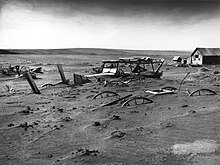Dust bowl


Dust Bowl ( German dust bowl ) were in the time of the Great Depression ( Great Depression ) in the United States and Canada parts of the Great Plains ( Great Plains called), which in 1930 years - from devastating - especially in the years 1935-1938 dust storms were affected . After clearing the prairie grass to " Reclamation (mainly" for a "new" or other agricultural use wheat ) had years of drought fatal.
The decimation or expulsion of the indigenous population (" Indians ") with their adapted economic and lifestyles (" nomadism ") and the associated almost complete extermination of the American bison , the livestock adapted to this habitat, had already preceded it .
Overview

The deep roots of the prairie grass, the stalks of which caught the dust, had protected the upper layers of soil from erosion , which was now setting in on a massive scale. The harvests were destroyed by drought and dust storms and people were literally blown into their homes.
Many farmers had to leave their soil when their financial resources were exhausted. They often looked for work in other regions of the United States, particularly in agricultural production in California . Here they competed with other migrant workers . At that time, the USA was economically badly hit by the global economic crisis and recorded extremely high unemployment .
One of the areas hardest hit by the drought in the United States was the state of Oklahoma . Almost 15% of the residents left the state, mainly heading west on the newly established Route 66 , which helped to establish the legendary fame of the Transversale. The emigrants became known as " Okies ". This name has become synonymous with those who fled the natural disaster . In Canada, the province of Saskatchewan was hardest hit.
In response to the events, the US government founded the Soil Conservation Service (now Natural Resources Conservation Service ), which deals with the conservation of natural resources. Based on their planning, the Great Plains Shelterbelt was created from 1935 to reduce the Dust Bowl , a 100 miles wide green belt as wind protection, from the north to the south border of the USA.
reception
The great dust storms left their mark on culture. In his novel The Fruits of Anger , John Steinbeck describes the migration of farmers to California as early as 1939. Due to the timeliness of the material, the film was made a year later. In California, however, the novel was banned for some time because of its strong social criticism. Folk singer Woody Guthrie described the Okies' social misery in his songs. The documentary photographer Dorothea Lange portrayed the impoverished refugees and made the extent of the misery clear for all those not affected.
The American television series Carnivàle (2003–2005) uses the Dust Bowl and its storms as a visually distinctive background for depicting a conflict between good and evil. Documentary filmmaker Ken Burns made a two-part TV documentary that first aired on PBS in November 2012 .
To accompany the filming, Dayton Duncan's book The Dust Bowl: An Illustrated History was created , which was also published in November 2012.
In 1989 Natalie Merchant described the anti-social effects of poverty in the title Dust Bowl of her band 10,000 Maniacs . More than 20 years later, an album by the American artist Joe Bonamassa was released in 2011 with the title Dust Bowl . On the 2009 album Sigh No More by the British band Mumford & Sons, there is a song called Dust Bowl Dance , which is essentially about guilt and social inequality.
literature
- David Montgomery : Dirt: Why our civilization is losing its feet. (Original title: Dirt: The Erosion of Civilizations. University of California Press , 2008, translated by Elke Walter), oekom, Munich 2010, ISBN 978-3-8658-1197-4 (= stories , volume 6).
- Dayton Duncan: The Dust Bowl: An Illustrated History. Chronicle Books, San Francisco 2012, ISBN 978-1-4521-0794-3 .
- Cook, BI, R. Seager, and JE Smerdon, 2014: The worst North American drought year of the last millennium: 1934. Geophys. Res. Lett., 41, no. 20, 7298-7305, early on-line, doi : 10.1002 / 2014GL061661 . Summary
- Donald Worster : Dust Bowl. The Southern Plains in the 1930s. New York: Oxford University Press, 1982, ISBN 0-19-503212-8 .
Web links
- Farming in the 1930s (Wessels Living History Farm)
- The Plow That Broke The Plains / Video
- deutschlandfunk.de , Dossier , June 17, 2016, Tom Lessokallow: The end of the nomads or the emergence of an ecological catastrophe
- Toni Ann Alexander: From Oklahomans to "Okies": Identity Formation in Rural California. Diss., Louisiana State University, Department of Geography and Anthropology 2004 (PDF; 2.0 MB)
Individual evidence
- ↑ The Dust Bowl - A Film by Ken Burns on pbs.org. Retrieved March 7, 2013 .